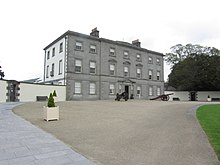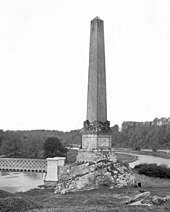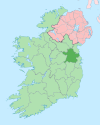Oldbridge

Oldbridge (Irish: An Seandroichead)[1] is a townland near Drogheda in County Meath, Ireland.[2] The area is home to the Boyne Navigation, the Battle of the Boyne Interpretive Centre and the southern half of the Mary McAleese Boyne Valley Bridge (which carries the M1 motorway).
Navigation
[edit]The townland represents the furthest tidal reach on the River Boyne at a point called the "Curly Hole". Curly Hole is also a fishing location.[3] Prior to the 12th century, this was the lowest crossing point of the Boyne. The Abbey of Mellifont owned the lands and fisheries here at dissolution in 1539. It was described then as "Oldebryge. 26 fishermen with 26 boats de Corrio (sc.corachs) paying £13.6.8". The Irish coracle was used for salmon fishing at this location up to at least the first half of the 20th century.[4] One of the last coracles made locally was made in 1928 by Michael O'Brien of Oldbridge, for Adolf Mahr director of the National Museum of Ireland.[5][6]
Battle of the Boyne Site
[edit]

The site of the Battle of the Boyne extends over an area west of the town of Drogheda. In the County Development Plan for 2000, Meath County Council rezoned the land at the eastern edge of Oldbridge, at the site of the main Williamite crossing, to residential status. A subsequent planning application for a development of over 700 houses was granted by Meath County Council and this was appealed by local historians to An Bord Pleanala (The Planning Board). In March 2008 after a long appeal process, An Bord Pleanala approved permission for this development to proceed.[citation needed]
The Battle of the Boyne Interpretive Centre is approximately 1-mile (1.6 km) to the west of the main crossing point, on Oldbridge Estate.[7][8] This facility was redeveloped in 2008 and is open to tourists.[8]
In early 2007, the newly elected First Minister of Northern Ireland, Ian Paisley, was invited to visit the battle site by the then Taoiseach Bertie Ahern. Following the invitation, Paisley commented that "such a visit would help to demonstrate how far we have come when we can celebrate and learn from the past so the next generation more clearly understands". The visit took place in May 2007 and a tree was planted in the grounds of Oldbridge House to mark the occasion.[9]
References
[edit]- ^ "An Seandroichead / Oldbridge". logainm.ie. Irish Placenames Commission. Retrieved 12 November 2018.
- ^ "Oldbridge Townland, Co. Meath". townlands.ie. Irish Townlands. Retrieved 12 November 2018.
- ^ "Salmon and Sea trout fishing - East - Boyne River". fishinginireland.info. Fishing in Ireland. Retrieved 12 November 2018.
- ^ "The Ancient Art of the Coracle". independent.ie. Independent News & Media. 2 April 2004. Retrieved 12 November 2018.
- ^ "A lost craft: coracle building on the Boyne". tcd.ie. Trinity College Dublin. 20 October 2016. Retrieved 12 November 2018.
- ^ "History of Ireland in 100 Objects - Boyne coracle, 1928". irishtimes.com. Irish Times. 24 November 2012. Retrieved 12 November 2018.
- ^ "Official Battle of the Boyne Interpretive Centre website". OPW. Retrieved 28 December 2014.
- ^ a b "Battle of the Boyne Visitor Centre". discoverireland.ie. Fáilte Ireland. Retrieved 12 November 2018.
- ^ "BBC News – Paisley and Ahern visit 1690 site". BBC. 11 May 2007. Retrieved 12 November 2018.

